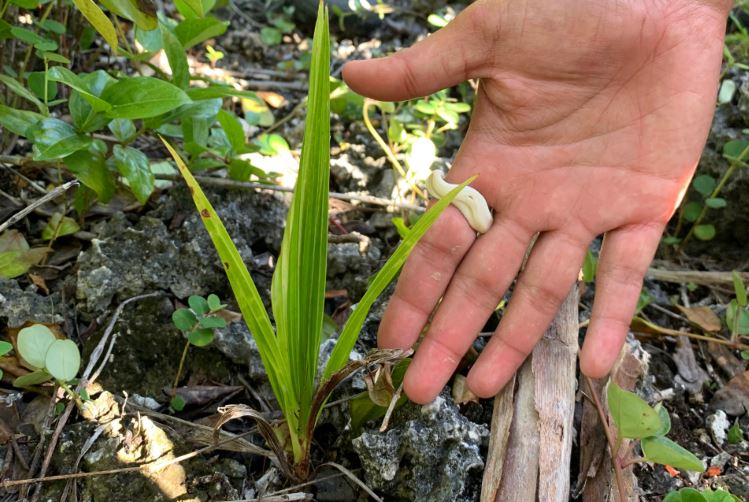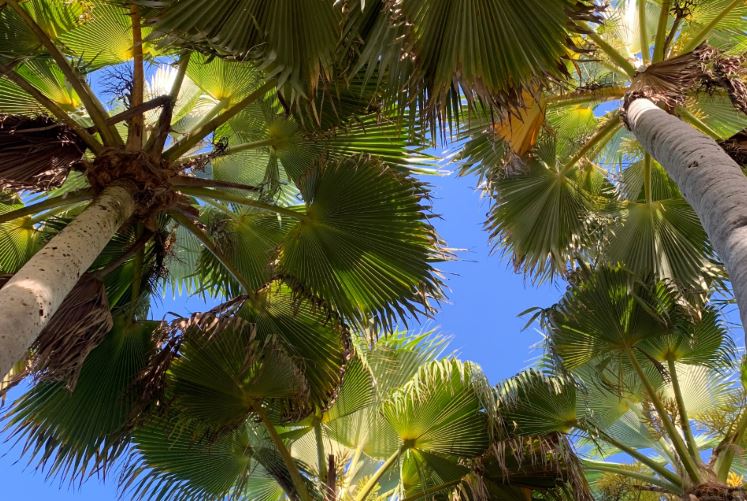Mitiaro Fan Palm Iniao making a come back
Saturday 11 March 2023 | Written by Te Ipukarea Society | Published in Environment, Local, National

New Iniao palm shoot contributing to the growing population on Mitiaro. NES/23031012
A simple search in the Cook Islands Biodiversity database shows the Cook Islands has 16 different types of Palms, with the majority being introduced for ornamental purposes. Two of the 16 have been identified as native. These are the common coconut palm, and the other, once thought to only be found on Mitiaro, the Mitiaro Fan Palm Pritchardia mitiaroana,locally known as the Iniao.
The Iniao is a small palm ranging in size from 4 to 6 metres in height, with a trunk typically 35 cm in diameter when mature. The crown of the tree has up to 25 fan shaped fronds, and can produce fruits of between 5 and 7 mm in diameter that become dark brown or black.
Baseline numbers for the Iniao in Mitiaro include those surveys conducted in 2015, where there were 375 plants found. Surveys using drone technology in 2019 recorded 491 mature palms.
Recent surveys by NES (National Environment Service) and MMR (Ministry of Marine Resources) found that the number of new shoots had double since 2019 with no decline in mature trees. A positive finding highlighting growth in abundance of the Iniao.
Previously, the Iniao was thought to be endemic (only found) in Mitiaro. However, a cluster of fan palms found in the Tuamotu islands (in Niau and Makatea) in French Polynesia was reclassified in 2007 as the same species (Hodel 2007).
It is well known that our ancestors as well as those from neighbouring Polynesian islands were expert voyagers. Dr Jean-Yves Meyer, chief of the Research Division in French Polynesia, with a background in botany and seabirds has hypothesised on how the Iniao may have first came to Mitiaro. Based on ancient Rarotongan stories and oral traditions written by P Smith in 1899, there was a strong “sea route” between Niau (formerly known as Fakaau, in the Tuamotus), Rarotonga and the Marquesas. From this frequently used route, it could have been quite possible that Polynesian voyagers had introduced the endemic Tuamotu Pritchardia to the Cook Islands.

The report in which Hodel claimed the endemic Tuamotu Palm as the same species as the Mitiaro Palm was not what is termed a “peer reviewed paper”. To officially confirm any link of the Iniao to the Tuamotus would require a phylogenetic study of Prichardia, comparing the Mitiaro fan to the one in Makatea and Niau.
Dr Jean-Yves Meyer carried out a survey of the Tuamotuan Pritcharadia on Niau in 2007 and counted about 100 mature trees. Dr Jean, now suggests there are about 1000 individuals including numerous juvenile plants present on Niau. Makatea has a few individuals today, due to the destructive phosphate mining industry causing deforestation.
To ensure the survival of the Iniao in the face of any future disaster, seeds could be collected for a seed bank. Accessible Iniao sites could also be better signed to inform the public about the significance of the Iniao, as well as potentially be used as a nursery to provide a head start for young Iniao plants.












































